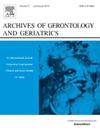Multi-trajectories of physical activity and health in aging: A 20-year nationwide population-based longitudinal study
IF 3.8
3区 医学
Q2 GERIATRICS & GERONTOLOGY
引用次数: 0
Abstract
Background
Although the beneficial effects of exercise in mitigating adverse health outcomes associated with aging are well-established, the optimal intensity, volume, and frequency of exercise, especially for older adults, remain to be fully elucidated. The aim of this study was to examine the longitudinal association between distinct trajectories of various aspects of physical activity and clinical outcomes (mortality and functional disability (Activities of Daily Living (ADL) and Instrumental Activities of Daily Living (IADL) disability) at 4- and 8-year follow-ups among community-dwelling middle-aged and older adults.
Methods
In this longitudinal cohort study, we identified 1914 community-dwelling adults from the Taiwan Longitudinal Study on Ageing, TLSA (1996–2015). Using group-based multi-trajectory modeling, we analyzed data from the third (1996) through the sixth (2007) wave of TLSA to identify distinct patterns across four self-reported physical activity aspects (frequency, duration, sweating intensity, and breathlessness intensity) among participants stratified by physical activity documented in the third wave survey (active vs. inactive). Cox proportional hazard models were used to examine the associations between these trajectory patterns and clinical outcomes (mortality, ADL/IADL disability) at 4-year (2011) and 8-year (2015) follow-ups.
Results
Among initially active participants, we identified three trajectories: "Declining Active" (n = 177), "Re-Engaged Active" (n = 200), and "Maintained Active" (n = 622). The "Maintained Active" group showed lower mortality risk at both 4-year (adjusted HR = 0.64, 95 %CI 0.44–0.93) and 8-year (adjusted HR = 0.65, 95 %CI 0.50–0.86) follow-ups compared to the "Declining Active" group. Among initially inactive participants, the "Emerging Active" group (n = 637) demonstrated lower mortality risk compared to the "Chronically Inactive" group (n = 278) at both time points (4-year: adjusted HR = 0.62, 95 %CI 0.43–0.90; 8-year: adjusted HR = 0.68, 95 %CI 0.52–0.89). The "Re-Engaged Active" group showed lower risk of ADL impairment (adjusted HR = 0.44, 95 %CI 0.21–0.87) at 8-year follow-up.
Conclusion
Maintaining active physical activity or transitioning from inactive to active status was associated with reduced mortality risk. These findings support promoting regular physical activity among older adults, regardless of baseline activity levels.
老年人身体活动与健康的多重轨迹:一项为期20年的全国人口纵向研究
虽然运动在减轻与衰老相关的不良健康结果方面的有益作用已得到证实,但运动的最佳强度、运动量和频率,特别是对老年人来说,仍有待充分阐明。本研究的目的是在4年和8年的随访中,研究社区居住的中老年人身体活动各方面的不同轨迹与临床结果(死亡率和功能性残疾(日常生活活动(ADL)和日常生活工具活动(IADL)残疾)之间的纵向关联。方法在这项纵向队列研究中,我们从台湾老龄化纵向研究(TLSA)(1996-2015)中选取了1914名社区居住的成年人。使用基于群体的多轨迹模型,我们分析了第三波(1996年)至第六波(2007年)的TLSA数据,以确定在第三波调查中记录的身体活动(活跃与不活跃)分层的参与者中,四个自我报告的身体活动方面(频率、持续时间、出汗强度和呼吸强度)的不同模式。在4年(2011年)和8年(2015年)的随访中,使用Cox比例风险模型来检查这些轨迹模式与临床结果(死亡率、ADL/IADL残疾)之间的关系。在最初活跃的参与者中,我们确定了三种轨迹:“减少活跃”(n = 177),“重新参与活跃”(n = 200)和“保持活跃”(n = 622)。与“减少运动”组相比,“保持运动”组在随访4年(调整HR = 0.64, 95% CI 0.44-0.93)和8年(调整HR = 0.65, 95% CI 0.50-0.86)时的死亡风险均较低。在最初不运动的参与者中,“新运动”组(n = 637)与“长期不运动”组(n = 278)在两个时间点(4年:调整后HR = 0.62, 95% CI 0.43-0.90;8年:调整后HR = 0.68, 95% CI 0.52-0.89)。在8年的随访中,“重新参与运动”组显示出较低的ADL功能障碍风险(调整HR = 0.44, 95% CI 0.21-0.87)。结论保持积极的身体活动或从不活跃状态过渡到活跃状态可降低死亡风险。这些发现支持在老年人中促进有规律的身体活动,而不管基线活动水平如何。
本文章由计算机程序翻译,如有差异,请以英文原文为准。
求助全文
约1分钟内获得全文
求助全文
来源期刊
CiteScore
7.30
自引率
5.00%
发文量
198
审稿时长
16 days
期刊介绍:
Archives of Gerontology and Geriatrics provides a medium for the publication of papers from the fields of experimental gerontology and clinical and social geriatrics. The principal aim of the journal is to facilitate the exchange of information between specialists in these three fields of gerontological research. Experimental papers dealing with the basic mechanisms of aging at molecular, cellular, tissue or organ levels will be published.
Clinical papers will be accepted if they provide sufficiently new information or are of fundamental importance for the knowledge of human aging. Purely descriptive clinical papers will be accepted only if the results permit further interpretation. Papers dealing with anti-aging pharmacological preparations in humans are welcome. Papers on the social aspects of geriatrics will be accepted if they are of general interest regarding the epidemiology of aging and the efficiency and working methods of the social organizations for the health care of the elderly.

 求助内容:
求助内容: 应助结果提醒方式:
应助结果提醒方式:


